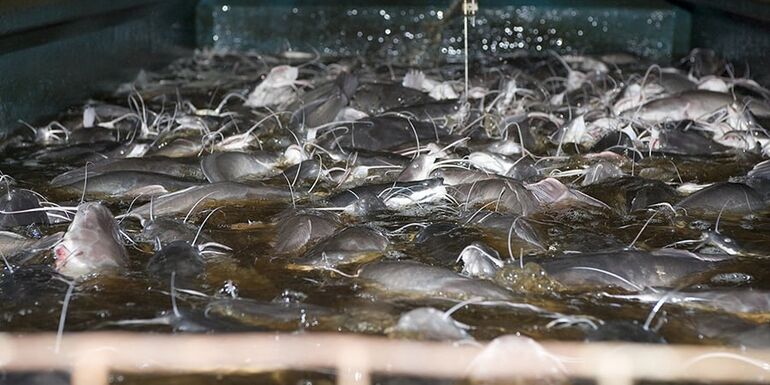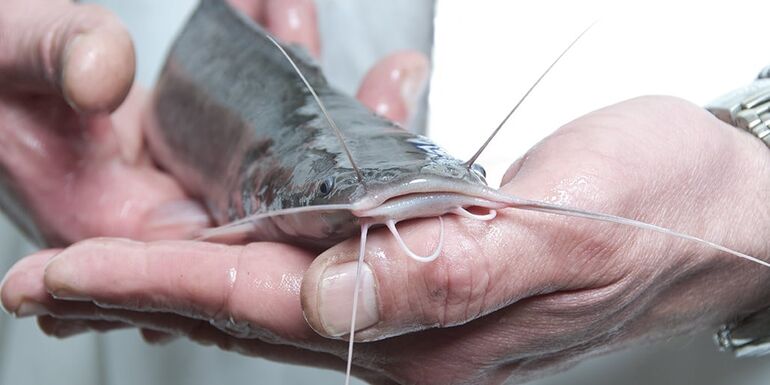
The African catfish (Clarias gariepinus) represents one of, if not the most ideal and exciting aquaculture species in the world.
These remarkable fish thrive in either temperate or tropical environments, exhibit very fast growth rates, possess high fillet yields and are tolerant of wide ranges of water quality, provided the water temperature is kept at approximately 27 °C. As such, African catfish are now farmed worldwide.

Breathing air at the water's surface
A unique feature of this species is the development of an accessory breathing organ, the labyrinth organ, which allows for the consumption of oxygen directly from the air instead of absorbing dissolved oxygen through the water column via the gills, as in almost every other fish species. This makes African catfish even more suitable as an aquaculture species as its unique ability to breathe air at the water’s surface means that it can be kept at higher densities compared to many other commonly farmed fish.
Alltech Coppens RAS feeds result in minimal waste products, and this is crucial for reducing the faecal matter present in the system, as well as in minimising ammonium excretion. Faeces produced after feeding must be large, firm and water-stable so that the mechanical filters can easily remove them. It is, therefore, crucial to know both the digestibility of each feed ingredient and also the characteristics of faeces resulting from the consumption of these raw materials when formulating a RAS feed for African catfish.
At the Alltech Coppens Aqua Centre, over 20 years of in-depth research has been carried out on methods of promoting the health of African catfish and the determination of their precise nutritional requirements. The main themes of our research program with African catfish involve investigating the digestibility of feed ingredients, the factors that influence feed intake, the effect of feed additives in promoting survival and gastrointestinal health and the improvement of water quality within African catfish farms in both flow-through and RAS environments. This research program ensures that our feeds are tailored to meet the needs of the fish, promote optimal nutrient retention and water quality and secure the success of our customers in supplying a highly nutritious and healthy product to end-consumers all over the world.
Diving deeper into these research topics, investigating the digestibility of feed ingredients is a vital step in securing the health of African catfish in RAS. Through meticulous research trials, Alltech Coppens has developed detailed protocols to determine the digestibility of a wide range of feed ingredients used in the production of high-performance RAS diets for this fish species. By determining the digestibility of these feed ingredients, we can ensure that our recipes meet the nutritional requirements of African catfish while simultaneously fortifying gut health and safeguarding the water quality of the farming environment of our customers. Such research also provides us with insights into raw materials that are not suitable for inclusion within our African catfish feed range. A poorly digestible raw material will lead to nutrient losses in the environment and, as such, the outcomes from our R&D efforts assure that only the highest-quality raw materials are selected for inclusion in our African catfish diets.
Further research has focused on the effect of novel feed additives in promoting the gastrointestinal health of African catfish. The results of these studies have led to the inclusion of a wide variety of additives within our feed range that safeguard the healthy growth of this fish species, from hatch to harvest. For example, the inclusion of Bio-Mos® and Actigen® within the feed premix preserves the microbial balance within the gastrointestinal system, ensuring a healthy and flourishing microflora. The inclusion of Bioplex® organic trace minerals also guarantees the efficient uptake of dietary micronutrients that are vital to building and developing a healthy skeletal structure and robust immune system.
Finally, an often-overlooked area of research is the effect of physical feed quality on the performance of farmed fish. The raw materials used within each feed, together with the extrusion parameters employed during production, will dictate the physical quality of the finished feed and an optimal physical pellet quality is fundamental to a successful RAS farm. In RAS, feed is mostly transported to the feeders automatically by air, spirals or chains. Such physical processes can result in a lot of friction on the pellets, which can lead to broken feed pellets and dust. Dust originating from a poor pellet quality can be detrimental to a RAS farming operation as it can irritate the gills of the fish, impair the nitrification process of the biofilters and subsequently lead to reduced growth rates and water pollution.


